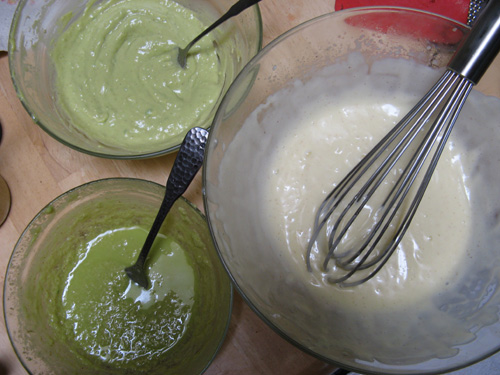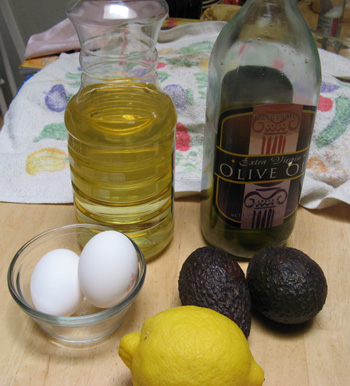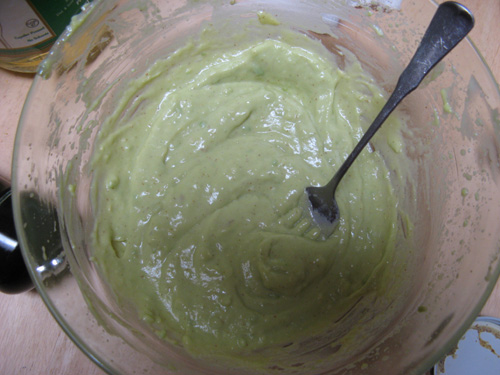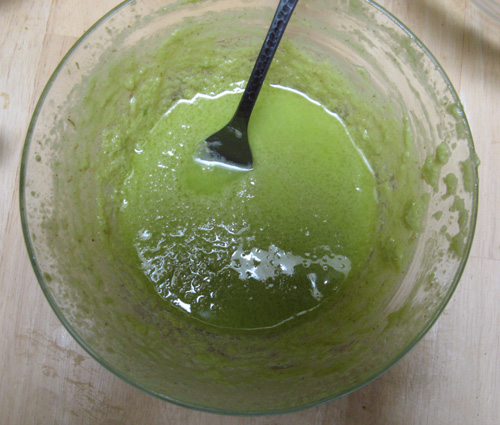Given that today is Mole Day, it seemed only fair to follow up on our earlier experimentation with avocados. You may recall that, in discussing our efforts to dissolve avocados, we said:
One further experiment we’ve decided to try at some future point is to investigate whether we can make mayonnaise substituting mashed avocado for some or all of the oil.
That future point? Now a past point.

Before I report the results from our kitchen, let’s talk a little about mayonnaise.

Mayonnaise is traditionally made up of oil, egg, and lemon juice (or something equivalent).
You know oil and water do not mix. Lemon juice contains citric acid, but it mostly acts like water in terms of its interactions with oil.
And, if you have experience with mayonnaise, you know it’s not supposed to look like oil floating on top of watery stuff. Rather than looking like a salad dressing that needs to be shaken, your typical mayo is white, opaque, thick, and creamy.
How it gets that way is the creation of an emulsion. Mayonnaise is an oil-in-water emulsion. Droplets of the oil are suspended in the aqueous part of the mayonnaise (the lemon juice), mediated by an emulsifier like egg yolk that has a hydrophobic part (which plays nice with the oil) and a hydrophilic part (which plays nice with the lemon juice).
However, the emulsion doesn’t just pop into existence when you put lemon juice, egg yolk, and oil in the same bowl. To coax the oil into the emulsion, you need to break the oil into tiny droplets. You can do this with a blender or food processor, or with a wire whisk and elbow grease.
We wanted to find out whether we could make mayo with avocado. But first, since I had never made the canonical homemade mayonnaise, we did that as a control.
We brought an egg to room temperature, then whisked it with 1 tablespoon of prepared mustard and 3 tablespoons of freshly squeezed lemon juice. (These measurements are approximate.)
While whisking, we gradually drizzled in some olive oil and some canola oil. (The olive oil was on the fruity side, so we only used a little of it.) We kept whisking and drizzling in oil until the mixture thickened up and developed a creamy appearance.

It tastes … like mayonnaise (with a distinct olive oil flavor note). Quite a lot of mayonnaise. Methinks I’ll be harvesting a cabbage and making coleslaw.
Having established that we could make mayo the standard way, the next question was what we could accomplish with avocado. Avocado has a pretty high oil content for a fruit. But we also noticed in our earlier experimentation that avocado seems to behave like an emulsifier. So, we wanted to try to answer two questions:
- Can we substitute avocado for some of the oil in mayonnaise?
- Can we use avocado as the main emulsifier in mayonnaise?
Avocado for oil:
As with our canonical mayonnaise, we started by whisking together an egg at room temperature, approximately 1 tablespoon of prepared mustard, and approximately 3 tablespoons of freshly squeezed lemon juice.
We added mashed avocado (approximately 1.5 avocado) to the egg mixture. Since we couldn’t really drizzle the mashed avocado, we added it all at once and then whisked vigorously. It very quickly resembled something mayo-like (although greenish instead of whitish). We then drizzled in a little canola oil while whisking and ended up with this:

It tastes like a lemony, avocado-y mayonnaise, and the texture is probably a little better than our canonical mayo.
Success!
Avocado for egg:
Here, we started with the mashed pulp of half an avocado, approximately 1 tablespoon of prepared mustard, and approximately 3 tablespoons of freshly squeezed lemon juice. We whisked this together and kept whisking while drizzling in the canola oil. Even though we whisked really vigorously, what we ended up with looked like this:

The oil just wasn’t persuaded to go into emulsion with the lemon juice. So, while there may be some emulsifiers in the avocado, they’re not quite as good at the job as the egg yolk.

Mmm – Tasty. Kind of looks like whipped guacamole, which I’ve seen made with mayo before (although i believe crema fresca is traditional). I got an idea, why not substitute both the oil and egg with avocado? Oh wait, that’s just guacamole…
So since Avocado has a high oil content, and can act as a emulsifier, it’s pretty much natures mayo on a tree (just add lemon)!
http://cooking-basics.suite101.com/article.cfm/5_quick_recipes_for_ripe_avocados
An inspired and interesting experiment. I may well try some variations on the avocado plus egg version myself (adding a bit of mashed garlic, maybe lime instead of lemon, and/or some dried ground chile).
Allow me a few comments on making “canonical” mayonnaise, which may help with your future efforts — I’m not sure what cannon your recipe was shot from, but you either took substantial liberties or the recipe was a misfire. 😉
1. Real traditional French mayonnaise (as opposed to Hellman’s) is made using only the egg yolks. Whole eggs are only used for making mayonnaise in a blender.
2. Traditional mayonnaise also uses dry, finely ground mustard (only about 1 tsp.), which then also acts to help stabilize the emulsion.
3. Your 3 tbsp. of lemon juice sounds like a lot for one egg’s worth of mayonnaise, and you probably should not start the whipping process with all of it in the bowl. The method I learned years ago from a French chef starts with only about 1/2 tsp. of lemon juice in the bowl, and uses a total of 2 tbsp. for two egg yolks worth of mayonnaise, with the remainder being added in small doses alternating with additions of oil *after* you have already incorporated 1/2 cup of oil.
4. Adding just a few grains of cayenne will give you a brighter taste with no detectable “heat.”
5. The purpose of using a wire whip is not just to create an emulsion, but also to incorporate as much air as possible, producing a thicker but less heavy finished sauce. It helps to tilt your bowl about 30 degrees and then to use an up-and-down rotating motion with your whip.
You didn’t give any approximation of the total volume of oil you added (which tends to vary, based on the size of the eggs, how vigorously you whip, and the prevailing barometric pressure and humidity — higher pressure and lower humidity let you add more oil). I can usually get a full cup of oil into two egg yolks on a clear, dry day.
Now we can speculate on what to put that avocado mayonnaise on/in. My first thought is just on slices of garden fresh tomato. With some additional seasoning (as in my first paragraph) it could make a nice dip for chips or crudités. For non-vegetarians, I imagine it could make a very tasty shrimp or crab salad.
Afterthoughts on an avocado-without-egg sauce. If you wanted to make a vegan sauce using avocado as a substitute for egg, I’d experiment with using a small quantity of potato or corn starch (mixed with the lemon juice at the start) to help incorporate more oil, and I’d probably use more avocado as well.
@chezjake:
If you want vegan/non-egg mayo, just by the stuff that makes egg yolk an emulsifier in the first place: lecithin. You can buy liquid lecithin at a health food shop (I got mine in the vitamin aisle at whole foods). It is derived from soy beans rather than egg. Apparently it can lower cholesterol and do other healthy things (which is why it’s in the vitamin aisle), but I bought purely to have a quick and easy liquid emulsifier in my kitchen (for, e.g., making foams or thickening a sauce).
So if avacado seeds were covered in emulsifiers, would they grow ok? And if you took the emulsification out of a chicken egg, would it still allow baby chicks to grow?
right, just egg yokes, i am french and that’s how i see my mother in law doing it when we gather. however i do not remember that i saw a lemon juice but a whisk? for certain and yes the bowl tilted. it was not whitish but rather yellowish, the french mayo has more tinginess due to more mustard in it (she uses ready made mustard). i find the american mayo to have a rather sweeter/blunter taste.
that sounds yummy!
I have one (OK 2) questions though. How long does it keep in the fridge & does it turn brown? -maybe the lemon juice helps?
this is silly. just use plain avocados in place of mayonnaise. avocados are very soft, and you can easily smash them into a cream. add a squirt of lime, a pinch of salt, mix, and store. easy as that.